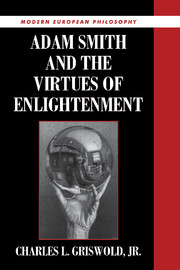Book contents
- Frontmatter
- Contents
- Texts and Acknowledgments
- Introduction
- 1 Rhetoric, Method, and System in The Theory of Moral Sentiments
- 2 Sympathy and Selfishness, Imagination and Self
- 3 The Passions, Pleasure, and the Impartial Spectator
- 4 Philosophy and Skepticism
- 5 The Theory of Virtue
- 6 Justice
- 7 The Moral Sentiments and The Wealth of Nations
- 8 Philosophy, Imagination, and the Fragility of Beauty: On Reconciliation with Nature
- Epilogue
- Bibliography
- Index
3 - The Passions, Pleasure, and the Impartial Spectator
Published online by Cambridge University Press: 10 November 2009
- Frontmatter
- Contents
- Texts and Acknowledgments
- Introduction
- 1 Rhetoric, Method, and System in The Theory of Moral Sentiments
- 2 Sympathy and Selfishness, Imagination and Self
- 3 The Passions, Pleasure, and the Impartial Spectator
- 4 Philosophy and Skepticism
- 5 The Theory of Virtue
- 6 Justice
- 7 The Moral Sentiments and The Wealth of Nations
- 8 Philosophy, Imagination, and the Fragility of Beauty: On Reconciliation with Nature
- Epilogue
- Bibliography
- Index
Summary
Thus I contend with fancy and opinion, and search the mint and foundery of imagination. For here the appetites and desires are fabricated; hence they derive their privilege and currency.
Earl of ShaftesburySmith's theory of moral sentiments makes emotion so central to human life that at first glance we may seem to be little more than creatures of the emotions. Smith distinguishes between emotions whose origin is in the body and those whose origin lies in “a particular turn or habit of the imagination” (I.ii.2.1). Given the great influence of those passions that originate in the imagination, not to mention the role that imagination plays in sympathy, we might also say with some accuracy that the imagination is the “mint and foundery” in which we are given shape. How are emotions, imagination, and understanding connected? How do the passions, or emotions, become “moral,” and how do they become corrupted? In this chapter, I continue examination of Smith's view of these matters, as well as of the closely related topics of pleasure and pain, the love of virtue, and the impartial spectator.
THE PASSIONS, IMAGINATION, AND THE CORRUPTION OF PLEASURE
The Passions and Imagination
Smith's view of the imagination, which emphasizes its creative capacity, both borrows from and extends Hume's treatment of the subject.
- Type
- Chapter
- Information
- Adam Smith and the Virtues of Enlightenment , pp. 113 - 146Publisher: Cambridge University PressPrint publication year: 1998



